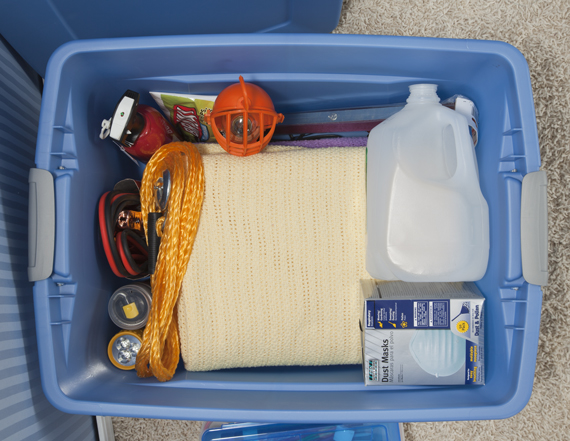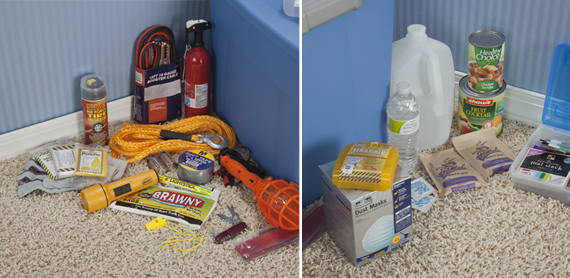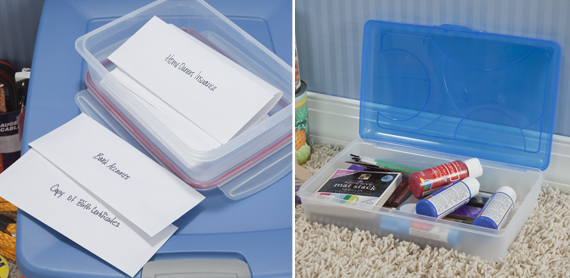by Michelle Wood of Sterilite Corporation
We survived the Mayan apocalypse, so now it’s time for a new year and a new beginning. Are you prepared? For many, January can be a harsh month with winter storms and power outages, and there are many potential unknowns beyond January that are worth spending some time preparing for in order to keep you and your loved ones safe. Make a point of starting the new year on the right foot by assembling an emergency preparedness kit using Sterilite storage products.
My emergency kit is assembled into a 22 Gallon Latch Tote. Here are the essentials plus a few other ideas to consider:
- Water – one gallon of water per person per day for at least three days, for drinking and sanitation; or at least one gallon of water in a reusable container and purification tablets.
- Food – at least a three-day supply of non-perishable food. Freeze dried and canned goods work well, just be sure to keep them up to date. You can even buy full meals in chewable tablet form for better space saving.
- Battery-powered or hand crank radio and a NOAA Weather Radio with tone alert and extra batteries for both
- Flashlight and extra batteries
- First aid kit with emergency blanket
- Whistle to signal for help. Flares can also be handy.
- Dust mask for all family members to help filter contaminated air
- Plastic sheeting and duct tape to help create a shelter and other building and repair uses
- Moist towelettes, garbage bags and plastic ties for personal sanitation
- Multitool, or at the very least a wrench or pliers to turn off utilities, a knife and can opener.
- Matches in a waterproof container
- Local maps
- Cell phone with charger, inverter or solar charger (Even if it is an old cell phone that you no longer have coverage on, you can still use it for 911 calls)

Once you have gathered the supplies for a basic emergency kit, you may want to consider adding the following items:
- Prescription medications and glasses (having an old pair of glasses is better than none!)
- Infant formula and diapers
- Pet food and extra water for your pet
- Cash or traveler's checks and change
- Important family documents such as copies of insurance policies, identification and bank account records in a watertight, portable container. The Sterilite Ultra•Seal™ 16.0 cup rectangular food storage container is perfect for this use. You can use the Emergency Financial First Aid Kit (EFFAK) developed by Operation Hope, FEMA and Citizen Corps to help you organize your information.
- Emergency reference material such as a first aid book
- Sleeping bag or warm blanket for each person. Consider additional bedding if you live in a cold-weather climate.
- Complete change of clothing including a long sleeved shirt, long pants and sturdy shoes. Consider additional clothing if you live in a cold-weather climate.
- Household chlorine bleach and medicine dropper – When diluted, nine parts water to one part bleach can be used as a disinfectant. Or in an emergency, you can use it to treat water by using 16 drops of regular household liquid bleach per gallon of water. Do not use scented, color safe or bleaches with added cleaners.
- Fire extinguisher
- Feminine supplies and personal hygiene items
- Mess kits, paper cups, plates, paper towels and plastic utensils
- Paper and pencil
- Car Essentials (jumper cables, tire inflator, emergency equipment)
- Books, games, puzzles, or other activities for children (I used a pencil box to keep these organized in my preparedness kit)

We all hope that the time spent preparing will be in vain and that the future is clear of disaster, but if that storm or other catastrophe presents itself, you will be very happy to have your emergency preparedness kit packed and on hand!
Wishing you and your family and happy and safe new year from your Sterilite bloggers.



Oooh, this looks good. I might try that honey cured stuff later, when I have time to experiment, espcaielly since some friends of ours have an apiary. I've been meaning to cure our own meat espcaielly since I've started to notice I'm really sensitive to something (probably the dye) in most cured meats.
Posted by: Dima | 03/02/2013 at 05:04 PM